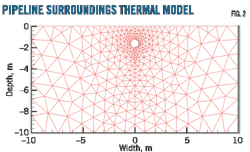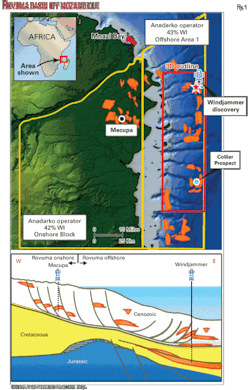Daryl Brown
Jim Cabe
Tyson Stout
Pacific Northwest National Laboratory
Richland, Wash.
This article describes development of a methodology and equations by Pacific Northwest National Laboratory for conceptual capital cost estimating of onshore pipelines using Oil & Gas Journal data (OGJ, Nov. 1, 2010, p. 102). It also describes construction cost trends uncovered during development of the methodology.
The purpose of this effort was to develop conceptual cost estimating equations for use in studies of future bio-liquid and hydrogen transmission pipelines, with adjustments as appropriate for fluid type. It sought relatively simple equations estimating a typical cost/mile as a function of pipe diameter. OGJ collects data from the US Federal Energy Regulatory Commission for material, labor, right-of-way, and miscellaneous cost categories and also identifies length, diameter, and state or states of construction. A 30-year collection of these data represents 2,000 pipeline segments covering all regions and allows a statistically valid analysis of variations in cost driven by the data set's variables.
Data adjustments
Pacific Northwest applied several adjustments to the raw data before examining trends. It divided total costs reported by the length of the pipeline segment to use $/mile costs and eliminated a handful of data sets with $/mile figures several times greater than the range for the rest of the data, as well as duplicate data sets for the same pipeline. Pacific Northwest then multiplied all pipeline cost estimates reported to FERC by the average ratios of actual/estimated costs (for each of the four cost categories) found in previous analyses by OGJ.
Adjusting cost data with the following indices brought all data forward to 2009 dollars:
- Chemical Engineering Plant Cost Index (CEPCI) for piping and valves for pipeline materials.
- CEPCI Construction Labor Index for pipeline construction labor.
- Gross Domestic Product Implicit Price Deflator (GDPIPD) for pipeline ROW.
The ratio of miscellaneous costs to the sum of material, labor, and ROW costs, however, was evaluated over time. All figures use postadjustment data.
Cost trends
Fig. 1 shows how the average pipeline cost/mile varies with length. Pipelines shorter than 0.1 miles long average about $6.2 million/mile, but those longer than 1 mile average consistently between $1.3 million and $1.9 million/mile. For short pipelines, fixed costs apparently dominate, while costs varying with length appear to dominate for pipelines longer than 1 mile long. For pipelines greater than 1 mile long, therefore, cost models predicting cost per mile can ignore pipeline length.
Fig. 2 shows how pipeline material costs/mile have varied over time. Although costs/mile appear constant at a glance, closer examination of the curve fit, as well as the curve-fit equation, show positive correlation with time, suggesting that the CEPCI index for piping and valves was not representative of actual cost trends for pipeline materials. Fig. 3, its curve fit, and curve-fit equation, however, show average pipeline diameter increasing from 24-28 in. between 1980 and 2009. This increase in average diameter almost exactly explains the positive increase in material cost not captured by the CEPCI piping and valves cost index.
Fig. 4 shows pipeline labor costs/mile having varied over time, with cost data adjusted to 2009 dollars by the CEPCI construction labor index. The factor-of-4 increase in labor cost/mile 1980-2009 suggests an increase in labor requirements in addition to any increase in labor rates.
Changes in labor requirements are not documented in the raw data but are probably well known to OGJ readers in the pipeline business. Multiplying the labor cost estimating equations developed from the adjusted data by the ratio of average adjusted cost in 2009 to the average adjusted cost in 1994, the midpoint of the data range, accounted for this increase in labor requirements.
Fig. 5 shows real (adjusted for general inflation) costs of pipeline ROW increasing by a factor of 5, or even more than construction labor. The ROW cost equations developed from the adjusted data were subject to the same additional adjustments applied to construction labor.
Fig. 6 shows how the average ratio of miscellaneous costs to nonmiscellaneous costs (material, labor, and ROW) has varied over time. Given that labor and ROW costs have both been increasing much faster than general inflation, the nearly factor-of-2 increase in this ratio means miscellaneous costs have been rising the fastest of the four pipeline cost components. With the curve-fit equation in Fig. 6, miscellaneous costs are currently about 37% of the sum of material, labor, and ROW costs.
Fig. 7 shows how the average cost/mile varies significantly with geographical location (see Table 1 for a listing of states included in each region) and justifies development of region-specific cost estimating equations. The New England states of Region 1 have the highest average cost/mile primarily because of significantly higher ROW costs (Fig. 8) as well as high labor costs (Fig. 9).
Average cost/mile in Region 1 would be even higher than shown in Fig. 7 if Region 1 did not also have one of the smallest average pipeline diameters (Fig. 9). The generally difficult topography and rocky soil conditions of Region 1 likely explain much of the higher labor costs, but it's not as clear why its ROW costs are so much higher than other similarly populated regions.
Equation accuracy
Table 2 shows the cost estimating equations resulting from this analysis. The equations were generally developed by selecting the equation with the highest R2 value from the standard single-variable options available within Excel. This approach presents a problem for developing cost estimating equations in that the ordinary-least-squares curve fitting methodology used in Excel and elsewhere values a $1 difference between the curve fit and an underlying datum the same regardless of the magnitude of each underlying datum.
The curve-fitting methodology is indifferent to a $1 error on a $1 item and a $1 error on a $1,000 item, making it possible for a curve fit with the best R2 to be quite poor at estimating costs at the lower end of the independent variable (diameter) range. Options for dealing with this problem, in order of increasing difficulty, include:
- Picking an alternative curve-fit equation type with slightly poorer R2 but better low-end fit.
- Breaking the curve fit into two or more independent variable ranges.
- Programming an alternative curve-fitting formula into Excel based on minimizing the sum of the squares of the ratios of predicted cost to actual cost rather than the sum of the squares of the difference between predicted and actual costs.
The authors used the first of these three options when the minimum R2 curve fit performed poorly at the low end of the diameter range.
The quality of cost-estimating equations developed can only be as good as the quality of the underlying data. There is no control for ensuring that pipeline companies have consistently reported costs to FERC over time or that reporting is consistent from one pipeline company to another. Still, the pipeline cost data collected by FERC and published by OGJ is the best publicly available.
The authors
Daryl Brown ([email protected]) is a staff engineer at the Pacific Northwest National Laboratory in Richland, Wash. He holds degrees in chemical engineering (1979) from Oregon State University and an MBA (1986) from the University of Washington. He is a member of AACE International and the Association of Energy Engineers.
Jim Cabe ([email protected]) is a research scientist at Pacific Northwest National Laboratory. He has previously served as a technical consultant for utilities and in the commercial power production field. He holds an undergraduate degree in chemistry from Willamette University (1994) and an MBA from Washington State University (2003).
Tyson Stout ([email protected]) is a postbachelor's research associate at Pacific Northwest National Laboratory. He holds a BS in Chemical Engineering (2009) from Washington State University. He is a member of the American Institute of Chemical Engineers.
More Oil & Gas Journal Current Issue Articles
More Oil & Gas Journal Archives Issue Articles
View Oil and Gas Articles on PennEnergy.com





